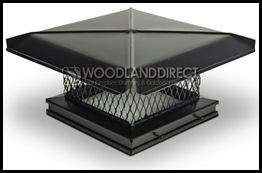More expensive is not always better when it comes to choosing the right chimney cap. Sometimes your needs may call for the less expensive alternative. A basic understanding of what is available will help you decide which metal is best for your chimney cap.
By mistake, a physiologist (Luigi Galvani) in Italy discovered an interesting phenomenon. When studying frogs that hung from a brass hook, he touched a steel scalpel to a nerve on the frog's leg. This caused the frogs leg to "reanimate" or twitch. What he discovered was what would become the basis for an understanding of dissimilar metal reactions, which later l ed to a number of scientific developments. Among the more notable achievements that sprung out of Galvani's work were batteries and galvanization of iron for the purpose of corrosion resistance.
ed to a number of scientific developments. Among the more notable achievements that sprung out of Galvani's work were batteries and galvanization of iron for the purpose of corrosion resistance.
Galvanized metal used in chimney caps is treated using what is known as hot dip galvanization. Untreated steel is passed through a molten zinc bath. The zinc "fuses" to the surface of the steel. This creates a coating of an iron-zinc alloy which is keyed or permanently attached to the steel body. Because the molecules of iron on the surface are bonded to zinc, they are not able to bond to oxygen. Iron oxide (rust) does not form as a result. After assembly, galvanized chimney caps are powdercoated for two reasons.
Reason 1: Unpainted galvanized steel is unsightly.
Reason 2: Galvanization is not completely effective and the ste el underneath will start to rust in 5-7 years. A paint coating helps prolong the life of the cap in addition to hiding the checkered look of unfinished galvanized steel.
Single flue black galvanized chimney cap and black galvanized steel caps are ideal for those who need protection but would rather avoid the expense of stainless steel or copper. They are typically the choice of contractors and builders forced to provide some protection due to building code requirements.
A significant upgrade from galvanized is stainless steel. Multi-flue chimney caps as well as single flue chimney caps are available in stainless steel. Custom caps can be made of this durable material as well.
Looking for a way to keep gun barrels clean, metallurgist Harry Brearley discovered the process by which we coat steel with an alloy containing Chromium. Much like the galvanization process, this creates a surfa ce on steel nearly impenetrable by oxygen. The difference being, stainless steel treatment is, excuse the pun, iron clad. A high quality stainless steel will outlast the structure to which it is attached. The cost of a stainless steel chimney cap may be a bit more, but it will last forever. Special grades of stainless steel can be used in coastal areas where salt corrosion is a concern.
ce on steel nearly impenetrable by oxygen. The difference being, stainless steel treatment is, excuse the pun, iron clad. A high quality stainless steel will outlast the structure to which it is attached. The cost of a stainless steel chimney cap may be a bit more, but it will last forever. Special grades of stainless steel can be used in coastal areas where salt corrosion is a concern.
Copper chimney caps are the cap of choice for those looking for a distinguished look. As permanent as the stainless steel unit, most home owners actually want their coppers caps to "corrode". The patination (the process by which copper turns green) is a welcome change for most. The formation of Copper Oxide is exactly the aged look that distinctive property owners are looking for. As copper is classified as a precious metal it is by far the most expensive choice when it comes to chimney caps.
No comments:
Post a Comment